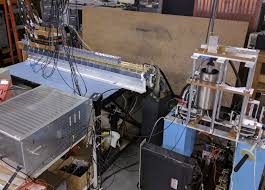
Breaking News
 "I've Always Gotten Along with President Putin" | Trump's TED Talk on War and Frie
"I've Always Gotten Along with President Putin" | Trump's TED Talk on War and Frie
 The court is calling: How pickleball is rewiring brains, one volley at a time
The court is calling: How pickleball is rewiring brains, one volley at a time
 SpaceX aims to launch Starship Flight 10 test flight on Aug. 24
SpaceX aims to launch Starship Flight 10 test flight on Aug. 24
 What is Peter Thiel's Role In The Technocratic Takeover Of Washington?
What is Peter Thiel's Role In The Technocratic Takeover Of Washington?
Top Tech News
 Chinese Scientists Produce 'Impossible' Steel to Line Nuclear Fusion Reactors in Major Break
Chinese Scientists Produce 'Impossible' Steel to Line Nuclear Fusion Reactors in Major Break
 1,000 miles: EV range world record demolished ... by a pickup truck
1,000 miles: EV range world record demolished ... by a pickup truck
 Fermented Stevia Extract Kills Pancreatic Cancer Cells In Lab Tests
Fermented Stevia Extract Kills Pancreatic Cancer Cells In Lab Tests
 3D printing set to slash nuclear plant build times & costs
3D printing set to slash nuclear plant build times & costs
 You can design the wheels for NASA's next moon vehicle with the 'Rock and Roll Challenge
You can design the wheels for NASA's next moon vehicle with the 'Rock and Roll Challenge
 'Robot skin' beats human reflexes, transforms grip with fabric-powered touch
'Robot skin' beats human reflexes, transforms grip with fabric-powered touch
 World's first nuclear fusion plant being built in US to power Microsoft data centers
World's first nuclear fusion plant being built in US to power Microsoft data centers
 The mitochondria are more than just the "powerhouse of the cell" – they initiate immune...
The mitochondria are more than just the "powerhouse of the cell" – they initiate immune...
 Historic Aviation Engine Advance to Unlock Hypersonic Mach 10 Planes
Historic Aviation Engine Advance to Unlock Hypersonic Mach 10 Planes
 OpenAI CEO Sam Altman Pitches Eyeball-Scanning World ID to Bankers
OpenAI CEO Sam Altman Pitches Eyeball-Scanning World ID to Bankers
Railguns Stabiliize ITER Nuclear Fusion Plasma Three Times Faster than Gas Guns

Princeton has developed an electromagnetic particle injector (EPI) which is a type of railgun that fires a high-velocity projectile from a pair of electrified rails into a plasma on the verge of disruption. The projectile, called a "sabot," releases a payload of material into the center of the plasma that radiates, or spreads out, the energy stored in the plasma, reducing its impact on the interior of the tokamak.
Current systems release pressurized gas or gas-propelled shattered pellets using a gas valve into the plasma, but with velocity limited by the mass of the gas particles.
The risk of disruptions is particularly great for ITER, the large international tokamak under construction in France to demonstrate the feasibility of fusion power. ITER's dense, high-power discharges of plasma, the state of matter that fuels fusion reactions, will make it difficult for current gas-propelled methods of mitigation to penetrate deeply enough into the highly energetic ITER plasma to take good effect.



